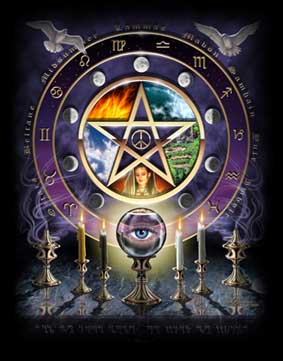|
Topics |
Twentieth Century Victorian Druids The Burning Times Miscellaneous Neopaganism
covers a wide range of belief systems which have emerged in the past 50
years, primarily in the UK, Europe, and the United States. This includes the better
known Wicca, which is a synthesis of traditions from the British Isles, as well as many less visible
groups which draw inspiration from other parts of the world. Based on
folk-lore, traditional spiritual practices, anthropology, and a
synthesis of esoteric systems, Neopaganism does not have any sacred
texts of the same vintage as other religions, although unverifiable
claims have been made in a couple of cases (e.g. Aradia, and The
Gardnerian Book of Shadows). Rather,
the books presented here are source texts of Neopaganism, and other
books which deal with related topics. Many of these books contain
outdated or speculative material, and some of the texts here are the
product of the Renaissance witch hunters. As a whole, the books here
are of historical importance rather than a roadmap to modern pagan
practice, and shouldn't be construed as such. As always, we encourage
readers to think critically. Descriptions
of contemporary Neopagan practice and beliefs can be found in the Internet Book of Shadows section of this
site. Twentieth
Century
The Gardnerian Book of Shadows The White Goddess.
The works of Margaret Murray. God
of the Witches [1933]
Pagan Prayers
by Marah Ellis Ryan [1913] Victorian
Letters on Demonology and Witchcraft
by Sir Walter Scott [1885]. Druids
Although
little is actually known about the Druids, that didn't stop 18th and
19th century intellectuals from building a romantic mythology around
them. This was closely associated with the rebirth of Celtic nationalism, as well as the
Romantic and Gothic movements. This
body of fact and speculation later became a central source of modern
Wicca and Neo-Pagan belief and practice.
Irish Druids and Old Irish Religions by James Bonwick [1894].
The Veil of Isis or Mysteries of the
Druids By W. Winwood Reade [1861]. 277,613
bytes The Religion of the Ancient Celts
by J. A. MacCulloch [1911] The Burning TimesFrom the
14th to the 17th Century a hysteria spread across Europe which involved
torturing and executing people based on accusations that they were
witches. Whether any actual practicioners of a pre-Christian pagan
tradition were persecuted as the result of a witch trial is up for
debate. These books and texts are period documents which illustrate the
methods, rationale (such as it was) and history of this persecution.
They shouldn't be taken as illustrative of Neopaganism, but as a
warning about religious tolerance and the fragile nature of justice.
The Malleus Maleficarum [1486],
translated by Montague Summers [1928]
Dæmonology by
King James the First. [1597] With Newes from Scotland [1591]
The Witch-Persecutions, Edited by George L. Burr [1896]. Miscellaneous
The Book of Hallowe'en by Ruth Edna Kelley [1919]
Irish Witchcraft and Demonology by St. John D. Seymore [1913]. |
|
